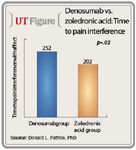Article
Denosumab results in less pain interference, according to study
Pain interference with daily functioning was significantly less in men with castrate-resistant prostate cancer who were treated with the RANK ligand inhibitor denosumab (XGEVA) compared to zoledronic acid (Zometa) as part of a multinational, double-blind, randomized trial.
Seattle-Pain interference with daily functioning was significantly less in men with castrate-resistant prostate cancer who were treated with the RANK ligand inhibitor denosumab (XGEVA) compared to zoledronic acid (Zometa) as part of a multinational, double-blind, randomized trial.

The study included 1,901 men with hormone-refractory castration-resistant prostate cancer and bone metastases; they were randomized to denosumab, 120 mg subcutaneously, and placebo every 4 weeks, or zoledronic acid, 4 mg intravenously, and placebo subcutaneously every 4 weeks. Men with current or past treatment with bisphosphonates were excluded.
Analgesic use was assessed using the eight-point Analgesic Quantification Algorithm.
The aggregate pain interference score increased from baseline through study month 18 among the entire cohort. Twenty-two percent more men in the denosumab group had a two-point or more decrease in the pain interference with general activity score than in the zoledronic acid group, said Dr. Patrick, professor and director of the Seattle Quality of Life Group, department of health service, University of Washington School of Public Health and Community Medicine, Seattle. Similar results were observed in pain interference with affect and activity.
More time to pain interference observed
Among the patients with no or mild pain at baseline, the time to pain interference with affect (≥2-point increase) was significantly longer in the denosumab group compared with zoledronic acid (252 days vs. 202 days, respectively; p=.02).
"The average relative difference [among patients with no/mild pain at baseline] in the proportion who had improvement in pain interference with affect was 38% in favor of denosumab," added Dr. Patrick, who presented the findings at the 2011 AUA annual meeting in Washington.
Among the entire cohort, 19% more men in the denosumab group had improvement in pain interference with affect.
There was a trend toward longer time to pain interference with activity (p=.08) among the men with no or mild pain at baseline who were randomized to denosumab versus zoledronic acid. Forty-one percent more men with no or mild pain at baseline who were treated with denosumab had improvement in pain interference with activity relative to those treated with zoledronic acid. Among the entire cohort, the average relative difference in this endpoint was 17% in favor of denosumab.
Eight percent fewer patients assigned to denosumab had an increase in the use of strong analgesics compared with zoledronic acid.
Dr. Patrick is a consultant/adviser for Amgen Inc., and his co-authors are consultants/advisers, investigators, employees, and/or have an investment interest in Amgen, Novartis, and/or Hybrigenics.
Newsletter
Stay current with the latest urology news and practice-changing insights — sign up now for the essential updates every urologist needs.





